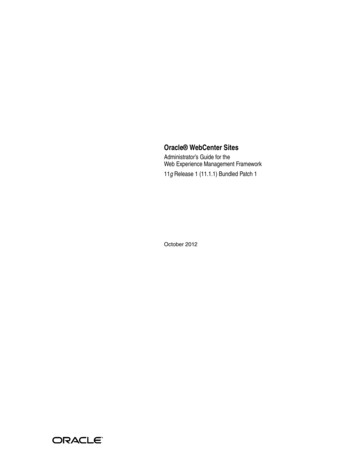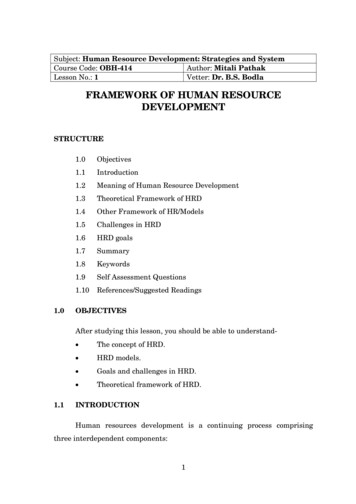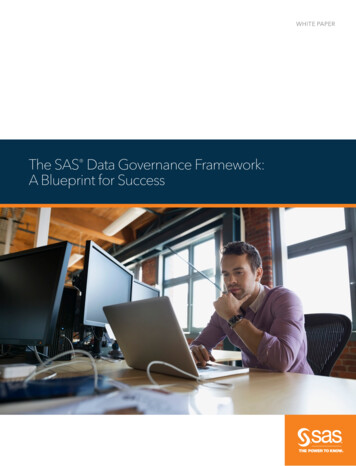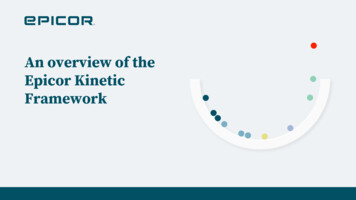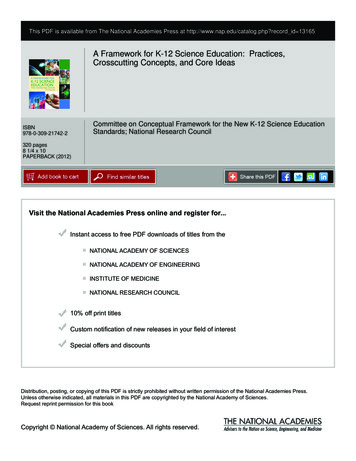
Transcription
This PDF is available from The National Academies Press at http://www.nap.edu/catalog.php?record id 13165A Framework for K-12 Science Education: Practices,Crosscutting Concepts, and Core IdeasCommittee on Conceptual Framework for the New K-12 Science EducationStandards; National Research CouncilISBN978-0-309-21742-2320 pages8 1/4 x 10PAPERBACK (2012)Visit the National Academies Press online and register for.Instant access to free PDF downloads of titles from theNATIONAL ACADEMY OF SCIENCESNATIONAL ACADEMY OF ENGINEERINGINSTITUTE OF MEDICINENATIONAL RESEARCH COUNCIL10% off print titlesCustom notification of new releases in your field of interestSpecial offers and discountsDistribution, posting, or copying of this PDF is strictly prohibited without written permission of the National Academies Press.Unless otherwise indicated, all materials in this PDF are copyrighted by the National Academy of Sciences.Request reprint permission for this bookCopyright National Academy of Sciences. All rights reserved.
A Framework for K-12 Science Education: Practices, Crosscutting Concepts, and Core IdeasA FRAMEWORK FORK-12 SCIENCEEDUCATIONPractices, Crosscutting Concepts, and Core IdeasCommittee on a Conceptual Framework for New K-12 Science Education StandardsBoard on Science EducationDivision of Behavioral and Social Sciences and EducationCopyright National Academy of Sciences. All rights reserved.
A Framework for K-12 Science Education: Practices, Crosscutting Concepts, and Core IdeasTHE NATIONAL ACADEMIES PRESS500 Fifth Street, N.W.Washington, DC20001NOTICE: The project that is the subject of this report was approved by the Governing Board of the National ResearchCouncil, whose members are drawn from the councils of the National Academy of Sciences, the National Academy ofEngineering, and the Institute of Medicine. The members of the committee responsible for the report were chosen fortheir special competences and with regard for appropriate balance.This study was supported by grant numbers D09121.R01 and D09121.R02 between the National Academy of Sciencesand the Carnegie Corporation of New York. Any opinions, findings, conclusions, or recommendations expressed in thispublication are those of the authors and do not necessarily reflect the views of the Carnegie Corporation of New York.International Standard Book Number-13: 978-0-309-21742-2International Standard Book Number-10: 0-309-21742-3Additional copies of this report are available from the National Academies Press, 500 Fifth Street, N.W., Lockbox 285,Washington, DC 20055; (800) 624-6242 or (202) 334-3313 (in the Washington metropolitan area); Internet, http://www.nap.edu.Copyright 2012 by the National Academy of Sciences. All rights reserved.Printed in the United States of AmericaSuggested citation: National Research Council. (2012). A Framework for K-12 Science Education: Practices, CrosscuttingConcepts, and Core Ideas. Committee on a Conceptual Framework for New K-12 Science Education Standards. Board onScience Education, Division of Behavioral and Social Sciences and Education. Washington, DC: The National AcademiesPress.Copyright National Academy of Sciences. All rights reserved.
A Framework for K-12 Science Education: Practices, Crosscutting Concepts, and Core IdeasThe National Academy of Sciences is a private, nonprofit, self-perpetuating society of distinguished scholars engaged inscientific and engineering research, dedicated to the furtherance of science and technology and to their use for the general welfare. Upon the authority of the charter granted to it by the Congress in 1863, the Academy has a mandate thatrequires it to advise the federal government on scientific and technical matters. Dr. Ralph J. Cicerone is president of theNational Academy of Sciences.The National Academy of Engineering was established in 1964, under the charter of the National Academy of Sciences,as a parallel organization of outstanding engineers. It is autonomous in its administration and in the selection of itsmembers, sharing with the National Academy of Sciences the responsibility for advising the federal government. TheNational Academy of Engineering also sponsors engineering programs aimed at meeting national needs, encourageseducation and research, and recognizes the superior achievements of engineers. Dr. Charles M. Vest is president of theNational Academy of Engineering.The Institute of Medicine was established in 1970 by the National Academy of Sciences to secure the services of eminentmembers of appropriate professions in the examination of policy matters pertaining to the health of the public. TheInstitute acts under the responsibility given to the National Academy of Sciences by its congressional charter to be anadviser to the federal government and, upon its own initiative, to identify issues of medical care, research, and education.Dr. Harvey V. Fineberg is president of the Institute of Medicine.The National Research Council was organized by the National Academy of Sciences in 1916 to associate the broadcommunity of science and technology with the Academy’s purposes of furthering knowledge and advising the federalgovernment. Functioning in accordance with general policies determined by the Academy, the Council has become theprincipal operating agency of both the National Academy of Sciences and the National Academy of Engineering in providing services to the government, the public, and the scientific and engineering communities. The Council is administeredjointly by both Academies and the Institute of Medicine. Dr. Ralph J. Cicerone and Dr. Charles M. Vest are chair andvice chair, respectively, of the National Research Council.www.national-academies.orgCopyright National Academy of Sciences. All rights reserved.
A Framework for K-12 Science Education: Practices, Crosscutting Concepts, and Core IdeasCopyright National Academy of Sciences. All rights reserved.
A Framework for K-12 Science Education: Practices, Crosscutting Concepts, and Core IdeasCOMMITTEE ON A CONCEPTUAL FRAMEWORK FOR NEW K-12 SCIENCEEDUCATION STANDARDSHELEN R. QUINN (Chair), Stanford Linear Accelerator Center, Stanford UniversityWYATT W. ANDERSON, Department of Genetics, University of Georgia, AthensTANYA ATWATER, Department of Earth Science, University of California, Santa BarbaraPHILIP BELL, Learning Sciences, University of Washington, SeattleTHOMAS B. CORCORAN, Teachers College, Columbia UniversityRODOLFO DIRZO, Department of Biology, Stanford UniversityPHILLIP A. GRIFFITHS, Institute for Advanced Study, Princeton, New JerseyDUDLEY R. HERSCHBACH, Department of Chemistry and Chemical Biology, Harvard UniversityLINDA P.B. KATEHI, Office of the Chancellor, University of California, DavisJOHN C. MATHER, NASA Goddard Space Flight Center, Greenbelt, MarylandBRETT D. MOULDING, Utah Partnership for Effective Science Teaching and Learning, OgdenJONATHAN OSBORNE, School of Education, Stanford UniversityJAMES W. PELLEGRINO, Department of Psychology and Learning Sciences Research Institute,University of Illinois at ChicagoSTEPHEN L. PRUITT, Office of the State Superintendent of Schools, Georgia Department ofEducation (until June 2010)BRIAN REISER, School of Education and Social Policy, Northwestern UniversityREBECCA R. RICHARDS-KORTUM, Department of Bioengineering, Rice UniversityWALTER G. SECADA, School of Education, University of MiamiDEBORAH C. SMITH, Department of Curriculum and Instruction, Pennsylvania State UniversityHEIDI A. SCHWEINGRUBER, Study Co-directorTHOMAS E. KELLER, Study Co-directorMICHAEL A. FEDER, Senior Program Officer (until February 2011)MARTIN STORKSDIECK, Board DirectorKELLY A. DUNCAN, Senior Program Assistant (until October 2010)REBECCA KRONE, Program AssociateSTEVEN MARCUS, Editorial ConsultantvCopyright National Academy of Sciences. All rights reserved.
A Framework for K-12 Science Education: Practices, Crosscutting Concepts, and Core IdeasBOARD ON SCIENCE EDUCATIONHELEN R. QUINN (Chair), Stanford Linear Accelerator Center, Stanford UniversityPHILIP BELL, Learning Sciences, University of Washington, SeattleGEORGE BOGGS, American Association of Community Colleges (retired), Washington, DCWILLIAM B. BONVILLIAN, Washington, DC, Office, Massachusetts Institute of TechnologyJOSEPH FRANCISCO, Department of Chemistry, Purdue UniversityADAM GAMORAN, Center for Education Research, University of Wisconsin–MadisonJERRY P. GOLLUB, Natural Sciences and Physics Departments, Haverford CollegeMARGARET A. HONEY, New York Hall of Science, New YorkJANET HUSTLER, Partnership for Student Success in Science (PS3), Synopsys, Inc., Mountain View,CaliforniaSUSAN KIEFFER, Department of Geology, University of Illinois, UrbanaBRETT D. MOULDING, Utah Partnership for Effective Science Teaching and Learning, OgdenCARLO PARRAVANO, Merck Institute for Science Education, Rahway, New JerseySUSAN R. SINGER, Department of Biology, Carleton CollegeWILLIAM B. WOOD, Department of Cellular and Developmental Biology, University of Colorado,BoulderMARTIN STORKSDIECK, DirectorHEIDI A. SCHWEINGRUBER, Deputy DirectorMICHAEL A. FEDER, Senior Program Officer (until February 2011)MARGARET L. HILTON, Senior Program OfficerTHOMAS E. KELLER, Senior Program OfficerNATALIE NIELSEN, Senior Program OfficerSHERRIE FORREST, Associate Program OfficerREBECCA KRONE, Program AssociateANTHONY BROWN, Senior Program AssistantKELLY DUNCAN, Senior Program Assistant (until October 2010)viCopyright National Academy of Sciences. All rights reserved.
A Framework for K-12 Science Education: Practices, Crosscutting Concepts, and Core RT I: A Vision for K-12 Science Education1A New Conceptual Framework2Guiding Assumptions and Organization of the Framework723PART II: Dimensions of the Framework3Dimension 1: Scientific and Engineering Practices414Dimension 2: Crosscutting Concepts835Dimension 3: Disciplinary Core Ideas—Physical Sciences1036Dimension 3: Disciplinary Core Ideas—Life Sciences139viiCopyright National Academy of Sciences. All rights reserved.
A Framework for K-12 Science Education: Practices, Crosscutting Concepts, and Core Ideas7 Dimension 3: Disciplinary Core Ideas—Earth and Space Sciences1698 Dimension 3: Disciplinary Core Ideas—Engineering, Technology, andApplications of Science201PART III: Realizing the Vision9 Integrating the Three Dimensions21710 Implementation: Curriculum, Instruction, Teacher Development, andAssessment 24111 Equity and Diversity in Science and Engineering Education27712 Guidance for Standards Developers29713 Looking Toward the Future: Research and Development to InformK-12 Science Education Standards311AppendixesABCDSummary of Public Feedback and Subsequent RevisionsBibliography of References Consulted on Teaching and LearningBiographical Sketches of Committee Members and StaffDesign Team MembersIndexviiiContentsCopyright National Academy of Sciences. All rights reserved.331347355365369
A Framework for K-12 Science Education: Practices, Crosscutting Concepts, and Core IdeasFOREWORDAFramework for K-12 Science Education represents the first step in aprocess to create new standards in K-12 science education. This projectcapitalizes on a major opportunity that exists at this moment—a largenumber of states are adopting common standards in mathematics and English/language arts and thus are poised to consider adoption of common standards inK-12 science education. The impetus for this project grew from the recognitionthat, although the existing national documents on science content for grades K-12(developed in the early to mid-1990s) were an important step in strengtheningscience education, there is much room for improvement. Not only has science progressed, but the education community has learned important lessons from 10 yearsof implementing standards-based education, and there is a new and growing bodyof research on learning and teaching in science that can inform a revision of thestandards and revitalize science education.In this context, the Carnegie Corporation of New York, together with theInstitute for Advanced Study, established a commission that issued a report entitled The Opportunity Equation, calling for a common set of standards in scienceto be developed. The Carnegie Corporation has taken a leadership role to ensurethat the development of common science standards proceeds and is of the highestquality by funding a two-step process: first, the development of this frameworkby the National Research Council (NRC) and, second, the development of a nextgeneration of science standards based on the framework led by Achieve, Inc. Weare grateful for the financial support of the Carnegie Corporation for this projectixCopyright National Academy of Sciences. All rights reserved.
A Framework for K-12 Science Education: Practices, Crosscutting Concepts, and Core Ideasand for their vision in establishing the partnership and two-step process for developing the new standards.This framework builds on the strong foundation of previous studies thatsought to identify and describe the major ideas for K-12 science education. Theseinclude Science for All Americans and Benchmarks for Science Literacy (1993),developed by the American Association for the Advancement of Science (AAAS),and the National Science Education Standards (1996), developed by the NRC.The framework is also informed by more recent work of two of our partner organizations: the AAAS (in Project 2061 especially) and the National Science TeachersAssociation (particularly the 2009 Anchors project). Achieve, Inc., our third partner is this endeavor, will lead the development of next-generation standards forscience education based on the framework presented in this report with the aspiration that many states will choose to adopt them. We look forward to workingwith these organizations in the dissemination and implementation of the vision ofscience and engineering education that the framework embodies.The framework highlights the power of integrating understanding the ideasof science with engagement in the practices of science and is designed to buildstudents’ proficiency and appreciation for science over multiple years of school.Of particular note is the prominent place given to the ideas and practices ofengineering.As presidents of the National Academy of Sciences and National Academyof Engineering, we are pleased to convey this report to interested readers. Webelieve that the education of the children of this nation is a vital national concern.The understanding of, and interest in, science and engineering that its citizensbring to bear in their personal and civic decision making is critical to good decisions about the nation’s future. The percentage of students who are motivatedby their school and out-of-school experiences to pursue careers in these fields iscurrently too low for the nation’s needs. Moreover, an ever-larger number of jobsrequire skills in these areas, along with those in language arts and mathematics.We thank the committee and the many consultants and NRC staff memberswho contributed to this effort, as well as the thousands who took the time tocomment on the draft that was made public in July 2010. That input contributedsubstantially to the quality of this final report.Ralph J. Cicerone, President, National Academy of SciencesCharles M. Vest, President, National Academy of EngineeringxForewordCopyright National Academy of Sciences. All rights reserved.
A Framework for K-12 Science Education: Practices, Crosscutting Concepts, and Core IdeasACKNOWLEDGMENTSTogether with the rest of the committee, I thank the many individuals andorganizations who assisted us in our work, without whom this study couldnot have been completed. We begin by acknowledging the generous supportof the Carnegie Corporation of New York, and particularly Andrés Henriquez, forhis attention to and patience with this project.Next we recognize the importance of the partnership we developed withAchieve, Inc., the American Association for the Advancement of Science, and theNational Science Teachers Association, and we are pleased to be continuing thispartnership. Each organization brought its unique perspective to our many partnermeetings, which led to a stronger report and better communication with the myriad communities with an interest in K-12 science education. Each of these partnershas an important role to play as the implementation of ideas in the frameworkdevelops.This report would not have been possible without the work of many individuals, teams, and organizations, and we hope we acknowledge them all here.The four design teams (listed in Appendix D) were critical in the development ofthe framework and providing the committee with insightful and creative modelsfor organizing the core ideas. We are deeply indebted to them and especially tothe four team leaders: Rodger Bybee, Joseph Krajcik, Cary Sneider, and MichaelWysession. These team leaders worked closely with the committee until thefinal stages of the project, tirelessly revising drafts of their work, discussing theresearch, debating possible approaches, and consistently going above and beyondtheir initial commitments. The work would have been impossible without them.xiCopyright National Academy of Sciences. All rights reserved.
A Framework for K-12 Science Education: Practices, Crosscutting Concepts, and Core IdeasThe committee also called on many individual experts in a variety of capacities. Some served as presenters, others provided detailed reviews of the draftframework released in July 2010, still others worked closely with groups of committee members to refine portions of the report, and a select few filled all threeroles. We acknowledge Valerie Akerson, Indiana University; Charles “Andy”Anderson, Michigan State University; Angela Calabrese Barton, Michigan StateUniversity; Anita Bernhardt, Department of Education, Maine; Nancy Brickhouse,University of Delaware; Ravit Golan Duncan, Rutgers University; Daniel Edelson,National Geographic Society; Jacob Foster, Massachusetts Department ofElementary and Secondary Education; Adam Gamoran, University of Wisconsin–Madison; David Hammer, University of Maryland, College Park; David Heil,David Heil & Associates; Leslie Herrenkohl, University of Washington; FrankKeil, Yale University; Rich Lehrer, Vanderbilt University; Kathy Metz, Universityof California, Berkeley; Jacqueline Miller, Education Development Center; AlbertoRodriguez, San Diego State University; Aaron Rogat, Columbia University; JoEllen Roseman, American Association for the Advancement of Science; LeonaSchauble, Vanderbilt University; Eugenie Scott, National Center for ScienceEducation; Susan Singer, Carleton College; Jean Slattery, Achieve, Inc.; CarolSmith, University of Massachusetts at Boston; Maria Varelas, University ofIllinois at Chicago; Beth Warren, TERC; Iris Weiss, Horizon Research, Inc.; andMarianne Wiser, Clark University.The committee also benefited from the extensive feedback on the draftreleased during the public comment period in summer 2010. We thank the largenumber of individuals who sent thoughtful comments as well as the many stakeholder groups and their leaders who were generous in recording and sending usdiscussion group feedback (see Appendix A). The committee found this feedbackinvaluable in revising the report, and we think it has greatly improved the qualityof the final document.We are also deeply grateful to the many individuals at the National ResearchCouncil (NRC) who assisted the committee. The success of a large project such asthe framework involves the efforts of countless staff members who work behindthe scenes. We acknowledge the support and commitment of the project codirectors, Heidi Schweingruber, whose dedication to this work was demonstratedtime and again at every stage of the work, and Tom Keller, who likewise playedmany critical roles in the process. We are grateful for the extensive, thoughtful, and cheerfully supportive work of additional staff of the Board on ScienceEducation (BOSE) who rose to the urgency of the task time and time again—KellyxiiAcknowledgmentsCopyright National Academy of Sciences. All rights reserved.
A Framework for K-12 Science Education: Practices, Crosscutting Concepts, and Core IdeasDuncan, Rebecca Krone, Michael Feder, Natalie Nielsen, Sherrie Forrest, MengfeiHuang (a Mirzyan fellow with BOSE), and Martin Storksdieck. Matthew VonHendy provided valuable research assistance.We also thank Kirsten Sampson Snyder, who shepherded the report throughthe NRC review process; Christine McShane, who edited the draft report; andYvonne Wise for processing the report through final production. We were alsoaided by the editorial skills of Steve Marcus; the work of the staff of the NationalAcademies Press, including Virginia Bryant, Rachel Marcus, and Stephen Mautner;and Doug Sprunger in the DBASSE communications office. We owe a special debtof thanks to Sara Frueh, who worked closely with project staff on communications and press issues and attended many meetings of the four partners to discusscommunication and dissemination strategy.Prior to the public comment period, the draft underwent a condensedversion of an NRC internal review. We thank the following individuals fortheir review of the draft report: Richard A. Duschl, College of Education,Pennsylvania State University; W.G. Ernst, Department of Geological andEnvironmental Sciences, Stanford University; Kim A. Kastens, Lamont-DohertyEarth Observatory, Columbia University; and Elizabeth K. Stage, Lawrence Hallof Science, University of California, Berkeley. The initial review was overseen byLauress (Laurie) L. Wise, Human Resources Research Organization (HumRRO),Monterey, CA; and Jerry P. Gollub, Physics Department, Haverford College.A revised draft of this report was reviewed by individuals chosen fortheir diverse perspective and technical expertise, in accordance with proceduresapproved by the NRC’s Report Review Committee. The purpose of this independent review is to provide candid and critical comments that will assist the institution in making its published report as sound as possible and to ensure that thereport meets institutional standards for objectivity, evidence, and responsiveness tothe study charge. The review comments and draft manuscript remain confidentialto protect the integrity of the deliberative process.We thank the following individuals for their review of this report: CristinaAmon, dean, Faculty of Applied Science and Engineering, alumni chair professor of bioengineering, Department of Mechanical and Industrial Engineering,University of Toronto; William B. Bridges, Carl F. Braun professor of engineering, emeritus, California Institute of Technology; Marye Anne Fox, chancellor,Office of the Chancellor, University of California, San Diego; Kenji Hakuta,School of Education, Stanford University; John M. Hayes, scientist emeritus,Woods Hole Oceanographic Institution; John R. Jungck, Department of Biology,AcknowledgmentsCopyright National Academy of Sciences. All rights reserved.xiii
A Framework for K-12 Science Education: Practices, Crosscutting Concepts, and Core IdeasBeloit College; Ron Latanision, corporate vice president, Exponent, Natick,MA; Richard Lehrer, Department of Teaching and Learning, Peabody College ofVanderbilt University; Michael E. Martinez, Department of Education, Universityof California, Irvine; Jennifer O’Day, principal research scientist, EducationProgram, American Institutes for Research, Sacramento, CA; Carlo Parravano,executive director, Merck Institute for Science Education, Rahway, NJ; R. BrucePartridge, Department of Astronomy, Haverford College; Roy D. Pea, School ofEducation, Stanford University; Jana Rowland, science education director, Officeof Standards and Curriculum, Oklahoma State Department of Education; PhilipRubin, chief executive officer, Haskins Laboratories, New Haven, CT; WilfriedSchmid, Mathematics Department, Harvard University; H. Eugene Stanley, university professor, and professor of physics, chemistry, physiology, and biomedicalengineering, Department of Physics, Boston University; Suzanne M. Wilson, chair,Department of Teacher Education, Michigan State University; William B. Wood,distinguished professor, emeritus, Department of Biology, University of Colorado,Boulder; Yu Xie, Otis Dudley Duncan distinguished university professor of sociology, Population Studies Center, University of Michigan; and Clarice M. Yentsch,adjunct research scientist, Oceanographic Center, Nova Southeastern University.Although the reviewers listed above have provided constructive commentsand suggestions, they are not asked to endorse the conclusions or recommendations, nor did they see the final draft of the report before its release. LorraineMcDonnell and Jerry P. Gollub oversaw the review of this report. Appointed bythe NRC, they were responsible for making certain that an independent examination of this report was carried out in accordance with institutional proceduresand that all review comments were carefully considered. Responsibility for thefinal content of this report rests entirely with the authoring committee and theinstitution.Finally, I would like to add my personal thanks, in particular to HeidiSchweingruber, without whose wise advice and support I could not have done mypart of the job, and to my colleagues on the committee for their enthusiasm, hardwork, and collaborative spirit in writing this report. They attended six meetingsof two or more days in length, freely provided their comments, engaged in spiriteddiscussion, read and commented on numerous drafts, and worked at a furiouspace.Helen R. Quinn, ChairCommittee on a Conceptual Framework for New K-12 Science Education StandardsxivAcknowledgmentsCopyright National Academy of Sciences. All rights reserved.
A Framework for K-12 Science Education: Practices, Crosscutting Concepts, and Core IdeasSUMMARYScience, engineering, and technology permeate nearly every facet of modernlife, and they also hold the key to meeting many of humanity’s most pressing current and future challenges. Yet too few U.S. workers have strongbackgrounds in these fields, and many people lack even fundamental knowledgeof them. This national trend has created a widespread call for a new approach toK-12 science education in the United States.The Committee on a Conceptual Framework for New K-12 ScienceEducation Standards was charged with developing a framework that articulatesa broad set of expectations for students in science. The overarching goal of ourframework for K-12 science education is to ensure that by the end of 12th grade,all students have some appreciation of the beauty and wonder of science; possesssufficient knowledge of science and engineering to engage in public discussions onrelated issues; are careful consumers of scientific and technological informationrelated to their everyday lives; are able to continue to learn about science outsideschool; and have the skills to enter careers of their choice, including (but not limited to) careers in science, engineering, and technology.Currently, K-12 science education in the United States fails to achieve theseoutcomes, in part because it is not organized systematically across multiple yearsof school, emphasizes discrete facts with a focus on breadth over depth, anddoes not provide students with engaging opportunities to experience how scienceis actually done. The framework is designed to directly address and overcomethese weaknesses.1Copyright National Academy of Sciences. All rights reserved.
A Framework for K-12 Science Education: Practices, Crosscutting Concepts, and Core IdeasThe framework is based on a rich and growing body of research on teachingand learning in science, as well as on nearly two decades of efforts to define foundational knowledge and skills for K-12 science and engineering. From this work, thecommittee concludes that K-12 science and engineering education should focus ona limited number of disciplinary core ideas and crosscutting concepts, be designedso that students continually build on and revise their knowledge and abilities overmultiple years, and support the integration of such knowledge and abilities with thepractices needed to engage in scientific inquiry and engineering design.The committee recommends that science education in grades K-12 be builtaround three major dimensions (see Box S-1 for details of each dimension). Thesedimensions are Scientific and engineering practicesCrosscutting concepts that unify the study of science and engineeringthrough their common application across fieldsCore ideas in four disciplinary areas: physical sciences; life sciences; earthand space sciences; and engineering, technology, and applications of scienceTo support students’ meaningful learning in science and engineering, allthree dimensions need to be integrated into standards, curriculum, instruction, andassessment. Engineering and technology are featured alongside the natural sciences(physical sciences, life sciences, and earth and space sciences) for two critical reasons: (1) to reflect the importance of understanding the human-built world and (2)to recognize the value of better integrating the teaching and learning of science,engineering, and technology.The broad set of expectations for students articulated in the framework isintended to guide the development of new standards that in turn guide revisions toscience-related curriculum, instruction, assessment, and professional developmentfor educators. A coherent and consistent approach throughout grades K-12 iskey to realizing the vision for science and engineering education embodied in theframework: that students, over multiple years of school, actively engage in scienceand engineering practices and apply crosscutting concepts to deepen their understanding of ea
A Framework for K-12 Science Education: Practices, Crosscutting Concepts, and Core Ideas ix A Framework for K-12 Science Education represents the first step in a process to create new standards in K-12 science education. This project capitalizes on a major opportunity that exists at this moment—a large



